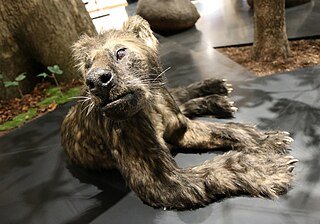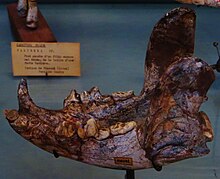
The red panda, also known as the lesser panda, is a small mammal native to the eastern Himalayas and southwestern China. It has dense reddish-brown fur with a black belly and legs, white-lined ears, a mostly white muzzle and a ringed tail. Its head-to-body length is 51–63.5 cm (20.1–25.0 in) with a 28–48.5 cm (11.0–19.1 in) tail, and it weighs between 3.2 and 15 kg. It is well adapted to climbing due to its flexible joints and curved semi-retractile claws.

In anatomy, a sesamoid bone is a bone embedded within a tendon or a muscle. Its name is derived from the Greek word for 'sesame seed', indicating the small size of most sesamoids. Often, these bones form in response to strain, or can be present as a normal variant. The patella is the largest sesamoid bone in the body. Sesamoids act like pulleys, providing a smooth surface for tendons to slide over, increasing the tendon's ability to transmit muscular forces.

Amphicyonidae is an extinct family of terrestrial carnivorans belonging to the suborder Caniformia. They first appeared in North America in the middle Eocene, spread to Europe by the late Eocene, and further spread to Asia and Africa by the early Miocene. They had largely disappeared worldwide by the late Miocene, with the latest recorded species at the end of the Miocene in Africa. They were among the first carnivorans to evolve large body size. Amphicyonids are colloquially referred to as "bear-dogs".

Nimravidae is an extinct family of carnivorans, sometimes known as false saber-toothed cats, whose fossils are found in North America and Eurasia. Not considered to belong to the true cats, the nimravids are generally considered closely related and classified as a distinct family in the suborder Feliformia. Fossils have been dated from the Middle Eocene through the Late Miocene epochs, spanning about 33.2 million years.

Ailuridae is a family in the mammal order Carnivora. The family consists of the red panda and its extinct relatives.

Megistotherium is an extinct genus of hyaenodont belonging to the family Hyainailouridae that lived in Africa.

Amphicyon is an extinct genus of large carnivorans belonging to the family Amphicyonidae, subfamily Amphicyoninae, from the Miocene epoch. Members of this family received their vernacular name for possessing bear-like and dog-like features. They ranged over North America, Europe, Asia, and Africa.

Barbourofelidae is an extinct family of carnivorans of the suborder Feliformia, sometimes known as false saber-toothed cats, that lived in North America, Eurasia and Africa during the Miocene epoch and existed for about 7.9 million years. Thought to be an independent lineage from the Nimravidae and Machairodontinae, which had all attained elongated canines, recent research argues that it may be a subfamily of the Nimravidae, extending its biochronological range into the Miocene, although this issue is not yet fully resolved.

Ursoidea is a superfamily of arctoid carnivoran mammals that includes the families Subparictidae, Amphicynodontidae, and Ursidae which the last family includes the extant lineages of bears as well the extinct Hemicyoninae and Ursavinae. The interrelationships of ursoids has had slight arrangements. In the past it was thought the extinct Amphicyonidae were stem-bears based on morphological analysis of the ear region, though the most recent publications on early amphicyonids suggests they were basal caniforms. The amphicynodontids are sometimes classified as either a subfamily of bears, a paraphyletic assemblage of early bears, or even stem-pinnipeds. The subparictids were previously classified as amphicynodontine/ids. The hemicyonines have been occasionally reclassified as a separate family.
Alopecocyon is a fossil genus of ailurid belonging to the subfamily Simocyoninae. It has two species, Alopecocyon goeriachensis and Alopecocyon getti. It is based on fragmentary fossils dating to the middle Miocene of both Europe and Asia.

Palaearctonyx is an extinct genus of omnivorous placental mammals from clade Carnivoraformes, that lived in North America from early to middle Eocene.

Agnotherium is a genus of large sized carnivoran mammals, belonging to the Amphicyonidae, which has been found in Western Europe, and possibly China and Northern Africa, and lived during the Late Miocene epoch. Despite only being known from fragmentary remains, the genus notable for hypercarnivorous adaptions, which have been said to represent the "apex" among its family.

Cerro de los Batallones is a hill at Torrejón de Velasco, Madrid, Spain where a number of fossil sites from the Upper Miocene (MN10) have been found. Nine sites have been discovered with predominantly vertebrate fossils, invertebrates and plants being less represented. The first deposits were discovered accidentally in July 1991.
Parailurus is a genus of extinct carnivoran mammal in the family Ailuridae. It was about 50% larger than Ailurus and lived in the early to late Pliocene Epoch, and its fossils have been found in Europe, North America, and Japan.
Sivanasua is an extinct genus of carnivorous mammal found across Miocene Europe including Germany, Austria, France, Spain and the Czech Republic. Like other lophocyonids, Sivanasua had unusual lophodont dentition, meaning the molars had ridges across the grinding surface of the molars, an adaptation believed to be indicative of a herbivorous diet.

Simocyoninae is an extinct subfamily of Ailuridae. The taxonomic history of this group was complicated, as researchers placed various fossil caniform genera into the subfamily. In addition to Simocyon, there was also Oligobunis, Cephalogale, and Enhydrocyon. This subfamily was initially classified within the Canidae or dog family. This idea went even further in 1910 when American paleontologist Henry Fairfield Osborn considered dholes, African wild dogs, and bush dogs to be the only extant representation left of the simocyonines. This was in large part to the overall similarity in the morphology of their molars, which suggested a shared ancestry of hypercarnivory. This view point was not supported by European paleontologists who believed that Simocyon was more closely related to musteloids. Soon the Simocyoninae were found as extinct subfamily of procyonids, or members of the raccoon-family, due to similarity of the basicranium of these animals. This was supported by subsequent researchers. It was not until a more completed skull of a Simocyon found in north Shaanxi, China was described by Wang (1997) who found that Simocyoninae is closely related Ailurinae on the basis of cranial and dental characteristics.

Thaumastocyoninae is an extinct subfamily of amphicyonids, large terrestrial carnivores, which inhabited what is now Europe during the Miocene epoch. The subfamily was erected by Hürzeler (1940), and is defined by the complete suppression of m1 metaconid, reduction of the premolars, except the p4, which is reinforced, and the oblique abrasion of the teeth, and the possession of hypercarnivorous tendencies. Thaumastocyonines are poorly known, with only about 65 dental specimens, most of those isolated teeth, being known as of 2020, although more complete remains have recently been discovered.

Actiocyon was an extinct genus of ailurid that existed from the Middle Miocene of North America. The type species, Actiocyon leardi, was described in 1947 by the American paleontologist Chester Stock.
Namibiocyon is an extinct genus of carnivoran mammals, belonging to the family Amphicyonidae, that lived in Namibia during the Early Miocene epoch. Before the erection of this taxon in 2022, the type and only species, N. ginsburgi, had been assigned to a variety of other genera. It is notable for its adaptions toward hypercarnivory.
Protursus is a fossil genus of ailurid with a single species Protursus simpsoni, known from a single left m2 tooth.














